26.2 Memory Construction Errors
26-
Memory is not precise. Like scientists who infer a dinosaur’s appearance from its remains, we infer our past from stored information plus what we later imagined, expected, saw, and heard. We don’t just retrieve memories, we reweave them. Like Wikipedia pages, memories can be continuously revised. When we “replay” a memory, we often replace the original with a slightly modified version (Hardt et al., 2010). (Memory researchers call this reconsolidation.) So, in a sense, said Joseph LeDoux (2009), “your memory is only as good as your last memory. The fewer times you use it, the more pristine it is.” This means that, to some degree, “all memory is false” (Bernstein & Loftus, 2009).
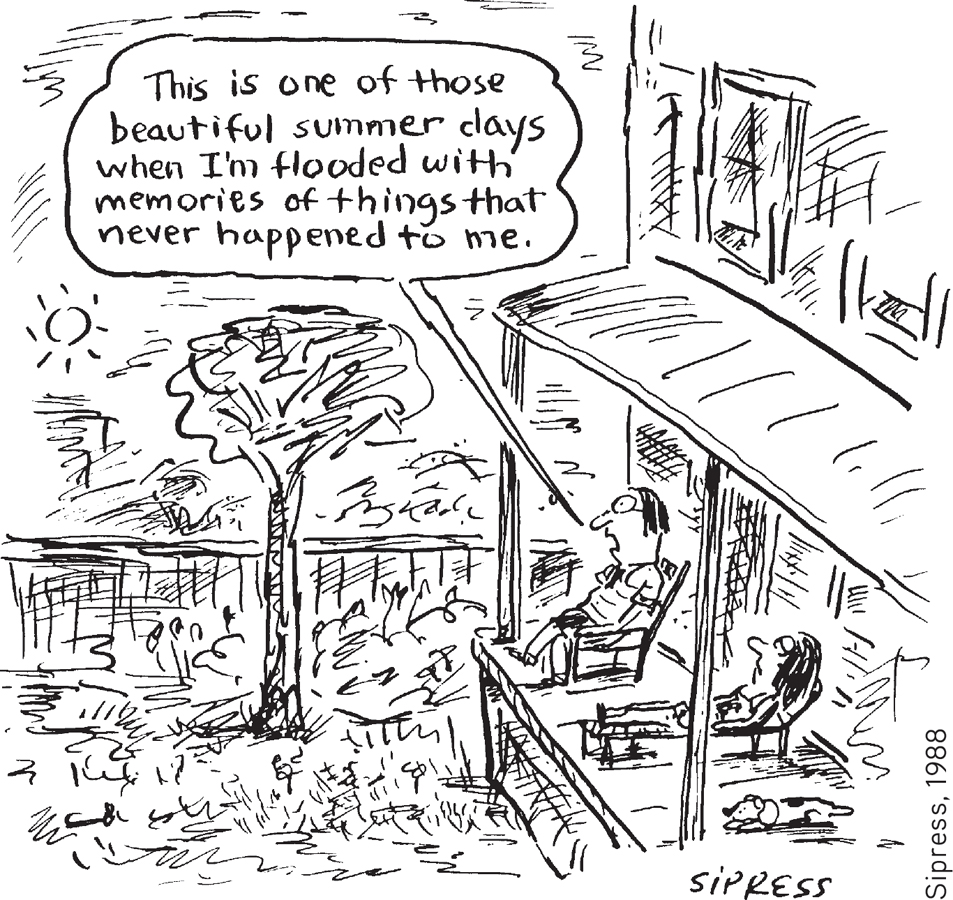
Despite knowing all this, I [DM] recently rewrote my own past. It happened at an international conference, where memory researcher Elizabeth Loftus (2012) was demonstrating how memory works. Loftus showed us a handful of individual faces that we were later to identify, as if in a police lineup. Later, she showed us some pairs of faces, one face we had seen earlier and one we had not, and asked us to identify the one we had seen. But one pair she had slipped in included two new faces, one of which was rather like a face we had seen earlier. Most of us understandably but wrongly identified this face as one we had previously seen. To climax the demonstration, when she showed us the originally seen face and the previously chosen wrong face, most of us picked the wrong face! As a result of our memory reconsolidation, we—
Clinical researchers are experimenting with people’s memory reconsolidation. They have people recall a traumatic or negative experience, then disrupt the reconsolidation of that memory with a drug or brief, painless electroconvulsive shock (Kroes et al., 2014; Lonergan, 2013). If, indeed, it becomes possible to erase your memory for a specific traumatic experience—
Misinformation and Imagination Effects
In more than 200 experiments involving more than 20,000 people, Loftus has shown how eyewitnesses reconstruct their memories after a crime or an accident. In one experiment, two groups of people watched a film clip of a traffic accident and then answered questions about what they had seen (Loftus & Palmer, 1974). Those asked, “About how fast were the cars going when they smashed into each other?” gave higher speed estimates than those asked, “About how fast were the cars going when they hit each other?” A week later, when asked whether they recalled seeing any broken glass, people who had heard smashed were more than twice as likely to report seeing glass fragments (FIGURE 26.8). In fact, the clip showed no broken glass.
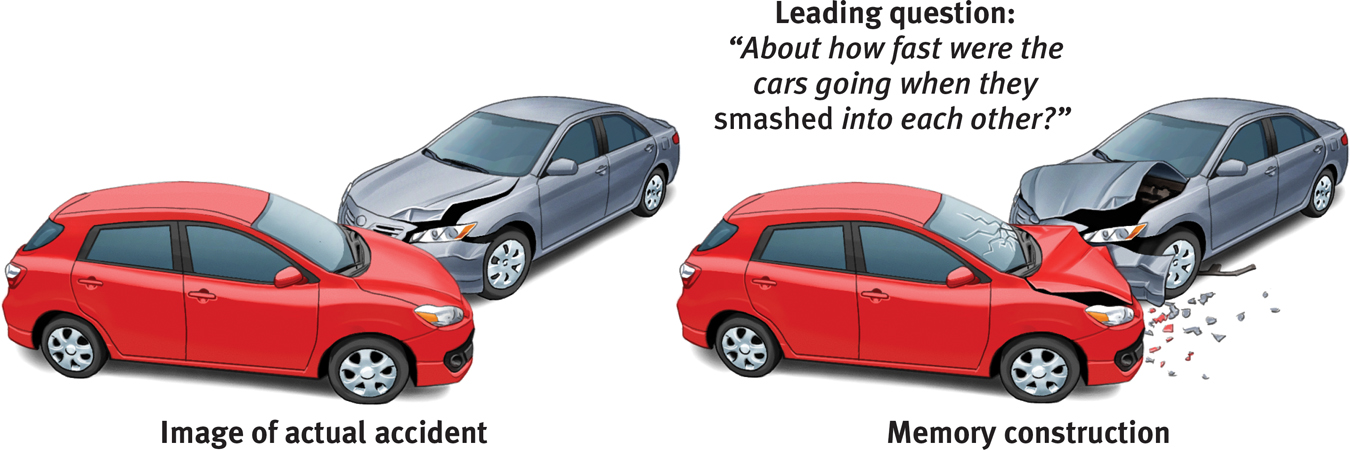
 Figure 26.8
Figure 26.8Memory construction In this experiment, people viewed a film clip of a car accident (left). Those who later were asked a leading question recalled a more serious accident than they had witnessed (Loftus & Palmer, 1974).
In many follow-
“Memory is insubstantial. Things keep replacing it. Your batch of snapshots will both fix and ruin your memory…. You can’t remember anything from your trip except the wretched collection of snapshots.”
Annie Dillard, “To Fashion a Text,” 1988
So powerful is the misinformation effect that it can influence later attitudes and behaviors (Bernstein & Loftus, 2009). One experiment falsely suggested to some Dutch university students that, as children, they became ill after eating spoiled egg salad (Geraerts et al., 2008). After absorbing that suggestion, they were less likely to eat egg salad sandwiches, both immediately and four months later.
Because the misinformation effect happens outside our awareness, it is nearly impossible to sift the suggested ideas out of the larger pool of real memories (Schooler et al., 1986). Perhaps you can recall describing a childhood experience to a friend and filling in memory gaps with reasonable guesses and assumptions. We all do it, and after more retellings, those guessed details—
Even repeatedly imagining nonexistent actions and events can create false memories. American and British university students were asked to imagine certain childhood events, such as breaking a window with their hand or having a skin sample removed from a finger. One in four of them later recalled the imagined event as something that had really happened (Garry et al., 1996; Mazzoni & Memon, 2003).
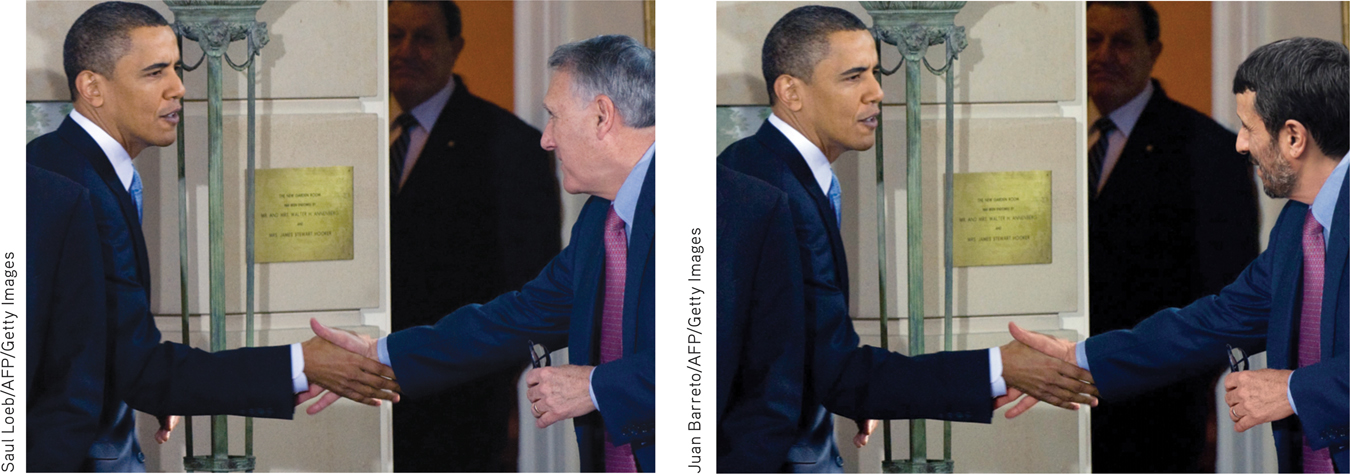

Digitally altered photos have also produced this imagination inflation. In experiments, researchers have altered photos from a family album to show some family members taking a hot air balloon ride. After viewing these photos (rather than photos showing just the balloon), children reported more false memories and indicated high confidence in those memories. When interviewed several days later, they reported even richer details of their false memories (Strange et al., 2008; Wade et al., 2002).
Misinformation and imagination effects occur partly because visualizing something and actually perceiving it activate similar brain areas (Gonsalves et al., 2004). Imagined events also later seem more familiar, and familiar things seem more real. The more vividly we can imagine things, the more likely they are to become memories (Loftus, 2001; Porter et al., 2000).
In British and Canadian university surveys, nearly one-
“It isn’t so astonishing, the number of things I can remember, as the number of things I can remember that aren’t so.”
Author Mark Twain (1835–1910)
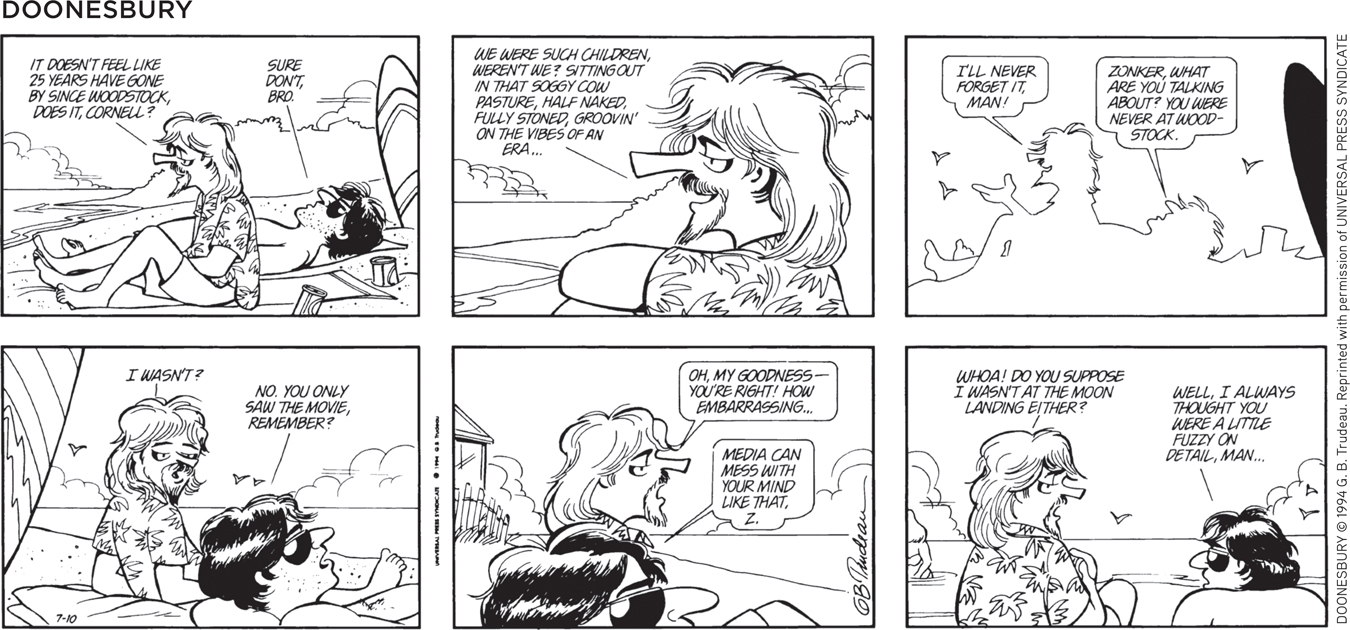
Source Amnesia
Among the frailest parts of a memory is its source. We may recognize someone but have no idea where we have seen the person. We may dream an event and later be unsure whether it really happened. We may misrecall how we learned about something (Henkel et al., 2000). Psychologists are not immune to the process. Famed child psychologist Jean Piaget was startled as an adult to learn that a vivid, detailed memory from his childhood—
Debra Poole and Stephen Lindsay (1995, 2001, 2002) demonstrated source amnesia among preschoolers. They had the children interact with “Mr. Science,” who engaged them in activities such as blowing up a balloon with baking soda and vinegar. Three months later, on three successive days, their parents read them a story describing some things the children had experienced with Mr. Science and some they had not. When a new interviewer asked what Mr. Science had done with them—
Source amnesia also helps explain déjà vu (French for “already seen”). Two-
“Do you ever get that strange feeling of vujà dé? Not déjà vu; vujà dé. It’s the distinct sense that, somehow, something just happened that has never happened before. Nothing seems familiar. And then suddenly the feeling is gone. Vujà dé.”
Comedian George Carlin (1937–2008), in Funny Times, December 2001
Alan Brown and Elizabeth Marsh (2009) devised an intriguing way to induce déjà vu in the laboratory. They invited participants to view symbols on a computer screen and to report whether they had ever seen them before. What the viewers didn’t know was that these symbols had earlier been subliminally flashed on the screen, too briefly for conscious awareness. The result? Half the participants reported experiencing déjà vu—
The key to déjà vu seems to be familiarity with a stimulus without a clear idea of where we encountered it before (Cleary, 2008). Normally, we experience a feeling of familiarity (thanks to temporal lobe processing) before we consciously remember details (thanks to hippocampus and frontal lobe processing). When these functions (and brain regions) are out of sync, we may experience a feeling of familiarity without conscious recall. Our amazing brains try to make sense of such an improbable situation, and we get an eerie feeling that we’re reliving some earlier part of our life. After all, the situation is familiar, even though we have no idea why. Our source amnesia forces us to do our best to make sense of an odd moment.
Discerning True and False Memories
Because memory is reconstruction as well as reproduction, we can’t be sure whether a memory is real by how real it feels. Much as perceptual illusions may seem like real perceptions, unreal memories feel like real memories.
False memories can be persistent. Imagine that we were to read aloud a list of words such as candy, sugar, honey, and taste. Later, we ask you to recognize the presented words from a larger list. If you are at all like the people tested by Henry Roediger and Kathleen McDermott (1995), you would err three out of four times—
 To participate in a simulated experiment on false memory formation, and to review related research, visit LaunchPad’s PsychSim 6: Can You Trust Your Memory?
To participate in a simulated experiment on false memory formation, and to review related research, visit LaunchPad’s PsychSim 6: Can You Trust Your Memory?
Memory construction helps explain why about 75 percent of 301 convicts exonerated by later DNA testing had been misjudged based on faulty eyewitness identification (Lilienfeld & Byron, 2013). It explains why “hypnotically refreshed” memories of crimes so easily incorporate errors, some of which originate with the hypnotist’s leading questions (“Did you hear loud noises?”). It explains why dating partners who fell in love have overestimated their first impressions of one another (“It was love at first sight”), while those who broke up underestimated their earlier liking (“We never really clicked”) (McFarland & Ross, 1987). And it explains why people asked how they felt 10 years ago about marijuana or gender issues recalled attitudes closer to their current views than to the views they had actually reported a decade earlier (Markus, 1986). How people feel today tends to be how they recall they have always felt (Mazzoni & Vannucci, 2007).
 For a 5-minute demonstration and explanation of a false memory experiment, visit LaunchPad’s Video—Creating False Memories: A Laboratory Study.
For a 5-minute demonstration and explanation of a false memory experiment, visit LaunchPad’s Video—Creating False Memories: A Laboratory Study.
One research team interviewed 73 ninth-
Children’s Eyewitness Recall
26-
If memories can be sincere, yet sincerely wrong, might children’s recollections of sexual abuse be prone to error? “It would be truly awful to ever lose sight of the enormity of child abuse,” observed Stephen Ceci (1993). Yet Ceci and Maggie Bruck’s (1993, 1995) studies of children’s memories have made them aware of how easily children’s memories can be molded. For example, they asked 3-
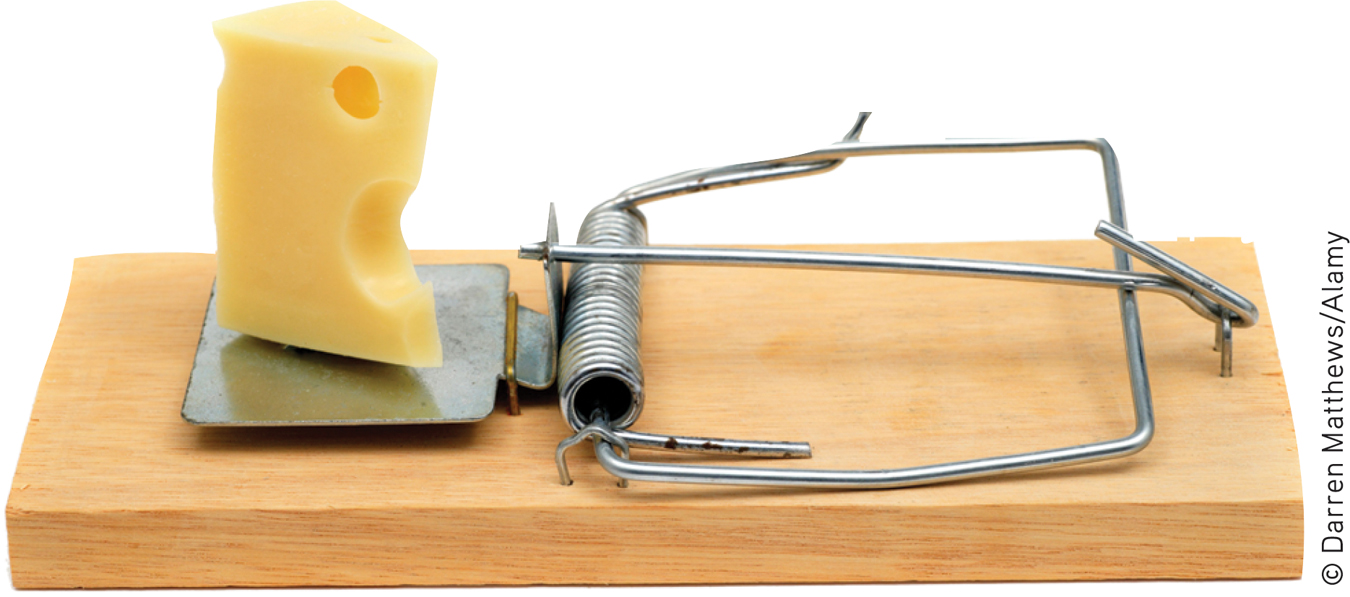
In other experiments, the researchers studied the effect of suggestive interviewing techniques (Bruck & Ceci, 1999, 2004). In one study, children chose a card from a deck of possible happenings, and an adult then read the card to them. For example, “Think real hard, and tell me if this ever happened to you. Can you remember going to the hospital with a mousetrap on your finger?” In interviews, the same adult repeatedly asked children to think about several real and fictitious events. After 10 weeks of this, a new adult asked the same question. The stunning result: 58 percent of preschoolers produced false (often vivid) stories regarding one or more events they had never experienced (Ceci et al., 1994). Here’s one:
My brother Colin was trying to get Blowtorch [an action figure] from me, and I wouldn’t let him take it from me, so he pushed me into the wood pile where the mousetrap was. And then my finger got caught in it. And then we went to the hospital, and my mommy, daddy, and Colin drove me there, to the hospital in our van, because it was far away. And the doctor put a bandage on this finger.

Consider how researchers have studied these issues with LaunchPad’s How Would You Know If People’s Memories Are Accurate?
Given such detailed stories, professional psychologists who specialize in interviewing children could not reliably separate the real memories from the false ones. Nor could the children themselves. The above child, reminded that his parents had told him several times that the mousetrap incident never happened—
THINKING CRITICALLY ABOUT
THINKING CRITICALLY ABOUT: Repressed or Constructed Memories of Abuse?
26-4 Why are reports of repressed and recovered memories so hotly debated?
There are two tragedies related to adult recollections of child abuse. One happens when people don’t believe abuse survivors who tell their secret. The other happens when innocent people are falsely accused. What, then, shall we say about clinicians who have guided people in “recovering” childhood abuse memories? Were these well-
The research on source amnesia and the misinformation effect raises concerns about therapist-
Critics are not questioning the professionalism of most therapists. Nor are they questioning the accusers’ sincerity; even if false, their memories are heartfelt. Critics’ charges are specifically directed against clinicians who have used “memory work” techniques, such as “guided imagery,” hypnosis, and dream analysis. “Thousands of families were cruelly ripped apart,” with “previously loving adult daughters” suddenly accusing fathers (Gardner, 2006). Irate clinicians countered that those who argue that recovered memories of abuse never happen are adding to abused people’s trauma and playing into the hands of child molesters.
Is there a sensible common ground that might resolve psychology’s “memory war”—which exposed researcher and expert witness Elizabeth Loftus (2011) to “relentless vitriol and harrassment”? Professional organizations (the American Medical, American Psychological, and American Psychiatric Associations; the Australian Psychological Society; the British Psychological Society; and the Canadian Psychiatric Association) have convened study panels and issued public statements, and greater agreement is emerging (Patihis et al., 2014). Those committed to protecting abused children and those committed to protecting wrongly accused adults have agreed on the following:
- Sexual abuse happens. And it happens more often than we once supposed. Although sexual abuse can leave its victims at risk for problems ranging from sexual dysfunction to depression (Freyd et al., 2007), there is no characteristic “survivor syndrome”—no group of symptoms that lets us spot victims of sexual abuse (Kendall-
Tackett et al., 1993). - Injustice happens. Some innocent people have been falsely convicted. And some guilty people have evaded responsibility by casting doubt on their truth-
telling accusers. - Forgetting happens. Many of those actually abused were either very young when abused or may not have understood the meaning of their experience—
circumstances under which forgetting is common. Forgetting isolated past events, both negative and positive, is an ordinary part of everyday life. - Recovered memories are commonplace. Cued by a remark or an experience, we all recover memories of long-
forgotten events, both pleasant and unpleasant. What psychologists debate is twofold: Does the unconscious mind sometimes forcibly repress painful experiences? If so, can these experiences be retrieved by certain therapist- aided techniques? (Memories that surface naturally are more likely to be verified [Geraerts et al., 2007].) - Memories of events before the age of 3 are unreliable. We cannot reliably recall happenings from our first three years. This infantile amnesia happens because our brain pathways have not yet developed enough to form the kinds of memories we will form later in life. Most psychologists—
including most clinical and counseling psychologists— therefore doubt “recovered” memories of abuse during infancy (Gore- Felton et al., 2000; Knapp & VandeCreek, 2000). The older a child was when suffering sexual abuse, and the more severe the abuse, the more likely it is to be remembered (Goodman et al., 2003). - Memories “recovered” under hypnosis or the influence of drugs are especially unreliable. Under hypnosis, people will incorporate all kinds of suggestions into their memories, even memories of “past lives.”
- Memories, whether real or false, can be emotionally upsetting. Both the accuser and the accused may suffer when what was born of mere suggestion becomes, like an actual trauma, a stinging memory that drives bodily stress (McNally, 2003, 2007). Some people knocked unconscious in unremembered accidents know this all too well. They have later developed stress disorders after being haunted by memories they constructed from photos, news reports, and friends’ accounts (Bryant, 2001).
The debate over repression and childhood sexual abuse, like many other scientific debates, has stimulated new research and new theories. Richard McNally and Elke Geraerts (2009; McNally, 2012) contend that victims of most childhood sexual abuse do not repress their abuse; rather, they simply stop devoting thought and emotion to it. McNally and Geraerts believe this letting go of the memory is most likely when
- the experience, when it occurred, was strange, uncomfortable, and confusing, rather than severely traumatic.
- the abuse happened once or only a few times.
- victims have not spent time thinking about the abuse, either because of their own resilience or because no reminders are available.
“When memories are ‘recovered’ after long periods of amnesia, particularly when extraordinary means were used to secure the recovery of memory, there is a high probability that the memories are false.”
Royal College of Psychiatrists Working Group on Reported Recovered Memories of Child Sexual Abuse (Brandon et al., 1998)
McNally and Geraerts agree that victims do sometimes accurately and spontaneously recall memories of childhood abuse. But these memories usually occur outside of therapy. Moreover, people who recall abuse spontaneously rarely form false memories when in a lab setting. Conversely, those who form memories of abuse during suggestive therapy tend to have vivid imaginations and score high on false-
So, does repression of threatening memories ever occur? Or is this concept—
RETRIEVAL PRACTICE
- Imagine being a jury member in a trial for a parent accused of sexual abuse based on a recovered memory. What insights from memory research should you offer the jury?
It will be important to remember the key points agreed upon by most researchers and professional associations: Sexual abuse, injustice, forgetting, and memory construction all happen; recovered memories are common; memories from before age 3 are unreliable; memories claimed to be recovered through hypnosis or drug influence are especially unreliable; and memories, whether real or false, can be emotionally upsetting.
Children can, however, be accurate eyewitnesses. When questioned about their experiences in neutral words they understood, children often accurately recalled what happened and who did it (Goodman, 2006; Howe, 1997; Pipe, 1996). When interviewers used less suggestive, more effective techniques, even 4-
Like children (whose frontal lobes have not fully matured), older adults—especially those whose frontal lobe functioning has declined—are more susceptible than young adults to false memories. This makes older adults more vulnerable to scams, as when a repair person overcharges by falsely claiming, “I told you it would cost x, and you agreed to pay” (Jacoby et al., 2005; Jacoby & Rhodes, 2006; Roediger & Geraci, 2007; Roediger & McDaniel, 2007).
RETRIEVAL PRACTICE
- What—given the commonality of source amnesia—might life be like if we remembered all our waking experiences and all our dreams?
Real experiences would be confused with those we dreamed. When meeting someone, we might therefore be unsure whether we were reacting to something they previously did or to something we dreamed they did.